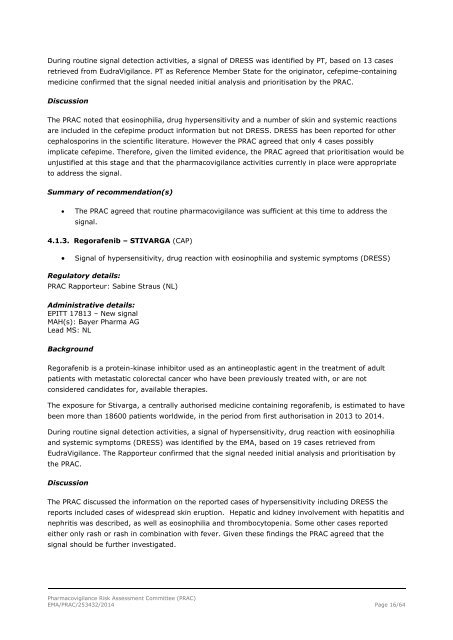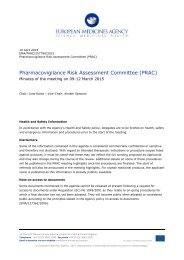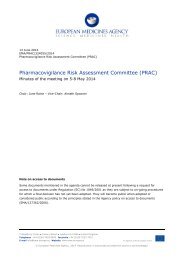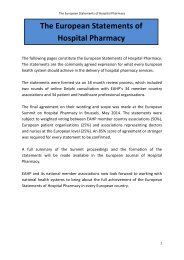WC500165698
WC500165698
WC500165698
You also want an ePaper? Increase the reach of your titles
YUMPU automatically turns print PDFs into web optimized ePapers that Google loves.
During routine signal detection activities, a signal of DRESS was identified by PT, based on 13 cases<br />
retrieved from EudraVigilance. PT as Reference Member State for the originator, cefepime-containing<br />
medicine confirmed that the signal needed initial analysis and prioritisation by the PRAC.<br />
Discussion<br />
The PRAC noted that eosinophilia, drug hypersensitivity and a number of skin and systemic reactions<br />
are included in the cefepime product information but not DRESS. DRESS has been reported for other<br />
cephalosporins in the scientific literature. However the PRAC agreed that only 4 cases possibly<br />
implicate cefepime. Therefore, given the limited evidence, the PRAC agreed that prioritisation would be<br />
unjustified at this stage and that the pharmacovigilance activities currently in place were appropriate<br />
to address the signal.<br />
Summary of recommendation(s)<br />
<br />
The PRAC agreed that routine pharmacovigilance was sufficient at this time to address the<br />
signal.<br />
4.1.3. Regorafenib – STIVARGA (CAP)<br />
<br />
Signal of hypersensitivity, drug reaction with eosinophilia and systemic symptoms (DRESS)<br />
Regulatory details:<br />
PRAC Rapporteur: Sabine Straus (NL)<br />
Administrative details:<br />
EPITT 17813 – New signal<br />
MAH(s): Bayer Pharma AG<br />
Lead MS: NL<br />
Background<br />
Regorafenib is a protein-kinase inhibitor used as an antineoplastic agent in the treatment of adult<br />
patients with metastatic colorectal cancer who have been previously treated with, or are not<br />
considered candidates for, available therapies.<br />
The exposure for Stivarga, a centrally authorised medicine containing regorafenib, is estimated to have<br />
been more than 18600 patients worldwide, in the period from first authorisation in 2013 to 2014.<br />
During routine signal detection activities, a signal of hypersensitivity, drug reaction with eosinophilia<br />
and systemic symptoms (DRESS) was identified by the EMA, based on 19 cases retrieved from<br />
EudraVigilance. The Rapporteur confirmed that the signal needed initial analysis and prioritisation by<br />
the PRAC.<br />
Discussion<br />
The PRAC discussed the information on the reported cases of hypersensitivity including DRESS the<br />
reports included cases of widespread skin eruption. Hepatic and kidney involvement with hepatitis and<br />
nephritis was described, as well as eosinophilia and thrombocytopenia. Some other cases reported<br />
either only rash or rash in combination with fever. Given these findings the PRAC agreed that the<br />
signal should be further investigated.<br />
Pharmacovigilance Risk Assessment Committee (PRAC)<br />
EMA/PRAC/253432/2014 Page 16/64








